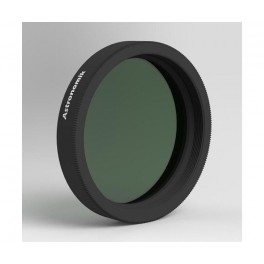 Ingrandisci
Ingrandisci Astronomik - O III Filter 6 nm - T2 mounted
Astronomik
- Rimuovi questo prodotto dai miei preferiti
- Aggiungi questo prodotto ai miei preferiti.
- Stampa
The Astronomik [O III] filter is a narrow band line filter for astro photography.
 Ingrandisci
Ingrandisci The Astronomik [O III] filter is a narrow band line filter for astro photography.
Codice articolo: 8h00nb
The Astronomik [O III] filter is a narrow band line filter for astro photography.
![The Astronomik [O III] filter is a narrow band line filter for astro photography. [EN] The Astronomik [O III] filter is a narrow band line filter for astro photography. [EN]](https://www.teleskop-express.it/img/cms/Astronomik-8h00nb-OIII-6nm-CCD-T2-M42x0-75-1000.jpg)
♦ 95% transmission of both [O III] lines
♦ Transmission range from 494 nm to 506 nm
♦ Complete blocking of all disturbing wavelengths
♦ Blocks IR also, necessary for digital photography
♦ Main operational use: planetary nebulae & supernova remnants
♦ Substrate optically polished
♦ No moisture-sensitivity, no aging, and totally scratch-proof
♦ Parfocal with other Astronomik filters
♦ 10 years warranty by manufacturer
♦ Connection: T2-thread
The Astronomik [O III] filter is a narrow band emission line filter for astro photography. The filter lets the light of double ionized oxygen of emission nebulae pass and blocks nearly the whole remainder of the spectrum where the sensor is sensitive. The full width at half maximum (FWHM) of 6 nm is optimal suitable for common astro cameras and allows the use of very fast optics. The optimal aperture ratio for the use of the filter is 1:3 to 1:15 with apertures of more than 6" (150 mm). It should be noted that the filter has a transmission of up to 99%, which cannot be attained by stacking more narrow-band filters. A further note, which led to selecting the half width (FWHM), is the dark current of common sensors. Exposures with a sensor cooled to -15 °C are limited by the dark current of the sensor, even in large cities with a bright background.
Another advantage of the 6 nm filter is the better availability of guiding stars for cameras with a built-in autoguider (SBIG). If you use a very strong filter like our H-alpha 6 nm filter, you often wont find a usable guidestar.
Together with our other two Astronomik emission-line filters ([S II] and H-alpha), you can make great color images even from very light polluted places!
Main use:
The Astronomik [O III] filter increases the contrast between objects, in this case between the [O III] emission lines and the skyglow background. This filter completely suppresses the emission lines of artificial lighting (mercury (Hg) and sodium (Na)) and skyglow. Transmission losses and chromatic distortions, which arise with other filters, only occur with Astronomik filters when extremely bright aperture ratios of 1:2 and more come into play. The filter has a built-in IR-blocker up to 1150 nm. You dont need an additional IR-blocker with this filter.
Other uses:
♦ When using the Astronomik [O III] filter together with the H-alpha and the [S II] filters you can obtain three-color images of emission line objects (gas nebulae) from locations with very strong light pollution. To do so, you would take an image in three different wavelengths, select each one as a color-channel in Photoshop and paste them together as one single color image.
♦ If you plan to create color images from emission line data, our CLS CCD filter is a great choice for the Luminance channel.
♦ The [O III] filter is also great for visual observation. If you plan to get filters for visual observation and for astrophotography, get the photographic filter: You may use this filter visual as well as in front of you camera. The built-in IR-blocker doesnt disturb visual observation, but you need an additional IR-blocker if you want to use the visual filter with your camera.
Filter transmission curve:![The Astronomik [O III] filter is a narrow band line filter for astro photography. [EN] The Astronomik [O III] filter is a narrow band line filter for astro photography. [EN]](https://www.teleskop-express.de/shop/Bilder/shop/astronomik-filter/astronomik-o3ccd-kurve.jpg)
♦ The horizontal axis is the wavelength in nanometers (nm). 400 nm is deep blue, at 520 nm the human eye senses green and at 600 nm red. At 656 nm is the famous "H-Alpha" emission line of hydrogen.
♦ The transmission in % is plotted on the vertical axis.
♦ The red line shows the transmission of the filter.
♦ Visual filters: The grey line in the background shows the relative sensitivity of the human eye at night. The maximum is at ~510 nm and drops to longer and shorter wavelengths. You can easily see, that you can´t see anything of the H-alpha line at night (even if you can during daylight!) The sensitivity at 656 nm is 0% at night!
♦ Photographic filters: The grey line in the background shows the sensitivity of a typical astro camera sensor.
♦ The most important artifical emission lines are shown in orange. The artifical light pollution is dominated by see mercury (Hg) and sodium (Na), which are used in nearly all streetlights.
♦ The most important emission lines from nebulas are shown in green. The most important lines are from ionized Hydrogen (H-alpha and H-beta) and double ionized oyxgen ([O III]). The square brackets indicate that these lines are forbidden.
Specifiche tecniche:
| Transmission of both [O III] lines: | 95% |
| Complete blocking of: | all disturbing wavelengths |
| IR blocking: | yes |
| Main operational use: | Planetary nebulae & supernova remnants |
| Anti reflective coating: | No moisture-sensitivity, no aging, and totally scratch-proof |
| Carrier material: | optically polished substrate |
| Parfocal: | With all other Astronomik filters |
| Glass thickness: | 1 mm |
| Filter cell: | Aluminum |
| Filter cell thickness: | 7.5 mm (without male thread) |
